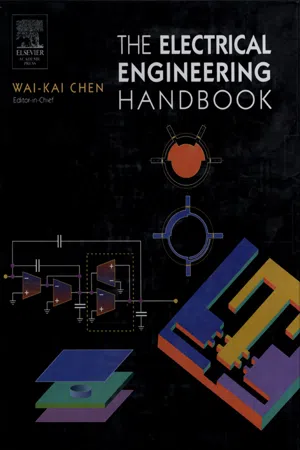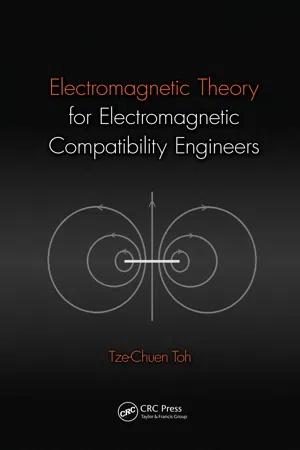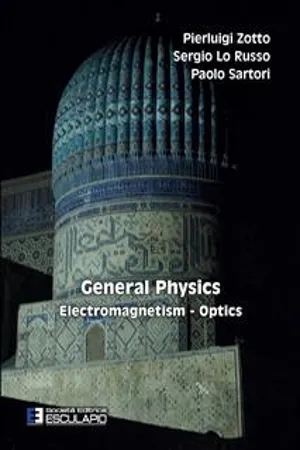Physics
Electrostatics Boundary Conditions
Electrostatics boundary conditions refer to the rules that govern the behavior of electric fields at the boundaries between different materials or regions. These conditions dictate how the electric field and electric potential must behave at the interface between two different mediums, such as conductors and insulators. They are crucial for understanding and solving electrostatics problems involving different materials and interfaces.
Written by Perlego with AI-assistance
Related key terms
1 of 5
4 Key excerpts on "Electrostatics Boundary Conditions"
- eBook - ePub
- Wai Kai Chen(Author)
- 2004(Publication Date)
- Academic Press(Publisher)
2Electrostatics
Rodolfo E. Diaz, Department of Electrical Engineering, Ira A. Fulton School of Engineering, Arizona State University, Tempe, Arizona, USA2.1. Introduction2.1.1. Conventions2.2. Sources and Fields2.2.1. D Fields of Charge Distributions Using Gauss’s Law2.2.2. First Alternative to Gauss’s Law: Integration over Charge Distributions 2.2.3. Second Alternative to Gauss’s Law: The Potential Function2.3. Boundary Conditions and Laplace’s Equation2.3.1. The Fields of Charged Conductors and the Method of Images 2.3.2. Laplace’s Equation and Boundary Value Problems2.3.3. The Connection Between D, P, E , and ε2.4. Capacitance2.4.1. Capacitance of Various Configurations and Energy 2.4.2. Partially Filled Capacitors 2.4.3. Static Current FieldsReferences2.1 Introduction
Electrostatics in its most restrictive sense is the specialization of Maxwell’s equations to a system whose sources are steady-state, time-invariant electric charges. Because the conservation of charge is implicit in this definition, the unifying principle of all the equations is the conservation of total electric flux. Therefore, electrostatics also properly includes steady-state conduction current problems.In this chapter, the fundamental relationship between source and field is between the electric charge q (measured in coulombs) and the electric flux density D (measured in coulombs per meter squared) because that relationship has the form of a conservation law. The electric field E (measured in volts per meter) is introduced with the concept of the electrostatic potential Φ (measured in volts) as the quantity involved in the dynamics of electrostatic systems (i.e., their interaction forces and energies). In this way, ε (measured in farads per meter), the permittivity of the material medium through which the flux traverses, appears as a proportionality constant that gauges the amount of energy stored in a given electrostatic system. Capacitance C (measured in farads) is then a purely geometric expression of the arrangement of that energy inside the system. The concepts of electrostatics are extended to the case of current flow in resistive environments by the recognition of the formal analogy between the electrostatic flux and the current density flux J (in amperes per meter2 - Tze-Chuen Toh(Author)
- 2016(Publication Date)
- CRC Press(Publisher)
67 3 Boundary Value Problems in Electrostatics No exposition on electrodynamics is complete without delving into some basic boundary value problems encountered in electrostatics. Indeed, neither would the exposition be complete if a cursory glimpse of multipole theory were absent [1,5–8]. The former is crucial to EMC engineers in developing an intuitive feel for real-world problems, and how simplifying a complicated scenario via a toy model can greatly help resolve electromagnetic interfer-ence problems. The latter is useful in understanding the basis for various rules of thumb employed by EMC engineers. Unfortunately, as is often the case, sometimes EMC engineers apply these rules with reckless abandon without being cognizant of the origins of the rules. Finally, the power of the method of images is developed further in this chapter. The technique is particularly useful for solving many problems encountered by EMC engineers. In particular, for 2-dimensional problems, utilizing techniques in complex variables [2,10] also come in very handy, and EMC engineers are encouraged to review the theory of analytic func-tions to solve two-dimensional Laplace equations encountered in electro-statics and magnetostatics. 3.1 Electromagnetic Boundary Conditions A brief summary of electromagnetic boundary conditions is collected here for ease of reference. The derivations can be found in Section A.3 of the Appendix. These conditions are utilized in subsequent sections to solve boundary value problems. By way of establishing some notations, let 3 Ω ⊂ ± R be two connected open sets such that 0 ∂Ω = Ω ∩Ω + -is a 2-dimensional sur-face. Given the pair Ω ε ∝ σ ± ± ± ± ( , , , ) , where ε ± is the electric permittivity, ∝ ± is the magnetic permeability, and σ ± is the conductivity on Ω ± consider an electric field -E in Ω -incident on ∂Ω 0 , and the resultant transmitted field + E in Ω + .- eBook - PDF
Steady Electric Fields and Currents
Elementary Electromagnetic Theory
- B. H. Chirgwin, C. Plumpton, C. W. Kilmister(Authors)
- 2013(Publication Date)
- Pergamon(Publisher)
Hence, in an electrostatic field the surface of a conduc-71 72 ELEMENTARY ELECTROMAGNETIC THEORY tor is an equipotential surface which carries a surface density of charge a; the latter, in general, is not uniform. (4) Because the boundary surface of a conductor is an equipotential sur-face of the electrostatic field and the field lines are orthogonal trajectories of these equipotential surfaces, the field lines at a point in the space immediately outside the conductor must lie along the normals to the conductor near that point. Also, the discontinuity in νΌ corresponding to the surface charge σ implies that at any point immediately outside a conductor the field is given by D = νσ = ε 0 Ε, (3.1) or Here the differentiation is taken along the normal drawn into the field. Also V = constant (3.3) on the surface, and inside the material, of a conductor. 3.2 Some general theorems When we discuss the general theorems of electrostatics it is essential that we consider the most general possible arrangements of charges and conductors. Then any particular fields examined later can be taken as special cases of this general arrangement. As pointed out earlier, electric charge is not rigidly fixed unless it is situated on an insulator. But this insulator may itself modify the field (see Chapter 4). Consequently, in the absence of solid dielectrics, a rigid distribution of charge, especially of volume charge, is unlikely to be realized in practice, even approximately. The most usual arrangement is a field in which a num-ber of conductors carry charges, or are maintained at stated potentials and are situated in a vacuum or, more likely, in air. (The difference between air and a vacuum for this purpose is negligible in most cases.) Nevertheless, we include the possibility of rigid distributions of charge in establishing the gen-eral theorems, although the usual applications are to fields established in the space between a number of charged conductors. - eBook - PDF
- Pierluigi Zotto, Sergio Lo Russo, Paolo Sartori(Authors)
- 2022(Publication Date)
- Società Editrice Esculapio(Publisher)
Electrostatic Field and Electrostatic Potential 2.1 Introduction Electrostatic force, as defined by Coulomb’s law, is formally identical to gravitational force, as expressed by Newton’s law, with the mere substitution of the mass of the bodies with their charge. It is therefore possible to define an electrostatic field, in full analogy with respect to the gravitational field definition, as the region of the space where an electrostatic force is exerted and it is also possible to associate an electrostatic potential with each point of this region. The general properties of an electrostatic force and of a gravitational force are obviously the same. 2.2 Electrostatic field Consider a point-like particle of mass m, charged with an amount of electric charge q, which lies in an empty space, that is in a region of the space where all the other bodies are placed at a very large distance from the selected body. Bring from infinite distance another point-like body which carries a charge ′ q (usually called test-charge) into this empty space and measure the intensity and the direction of the force being exerted between the two charges q and ′ q in each point P which belongs to this space. This operation draws a map of the electrostatic force vector F = 1 4πε 0 q ′ q r 2 u r , where u r is the unit vector of a polar coordinate reference system whose origin is chosen in point O, where body m is placed. Such a map is correct only if the size of body m with respect to the distance from point P, where charge ′ q is placed, is truly negligible, because electrostatic induction causes charge displacement both inside the body and on its surface. The map is therefore exact in the whole space only if the charge ′ q has a negligible value and therefore it cannot generate any relevant displacement of charge q which modifies how it is distributed in a body.
Index pages curate the most relevant extracts from our library of academic textbooks. They’ve been created using an in-house natural language model (NLM), each adding context and meaning to key research topics.



